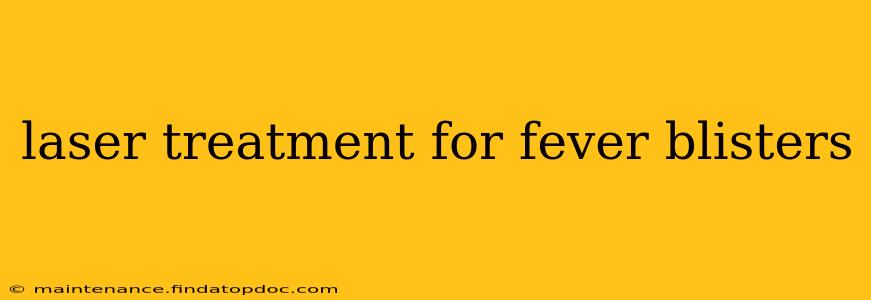Fever blisters, also known as oral herpes, are a common viral infection causing painful, fluid-filled sores on the lips and surrounding areas. While typically resolving on their own within a week or two, laser treatment offers a faster and potentially less uncomfortable approach for managing these bothersome lesions. This guide explores laser treatment options, addressing common questions and concerns surrounding this modern approach to fever blister management.
What is Laser Treatment for Fever Blisters?
Laser treatment for fever blisters utilizes specific wavelengths of light to target the affected tissue, accelerating the healing process and potentially reducing the duration and severity of symptoms. Different types of lasers may be employed, each with its own mechanism of action. For example, some lasers work by stimulating collagen production, promoting faster tissue repair. Others might target the virus directly, though this is less common than the focus on tissue repair.
How Effective is Laser Treatment for Fever Blisters?
The effectiveness of laser treatment varies depending on several factors, including the type of laser used, the severity of the outbreak, and the individual's response. While studies suggest laser therapy can significantly reduce healing time and pain associated with fever blisters, it's not a guaranteed cure. Moreover, it's crucial to understand that laser treatment addresses the symptoms, not the underlying viral infection (herpes simplex virus). The virus remains dormant in the body, and future outbreaks are possible.
What are the Different Types of Lasers Used for Fever Blisters?
Several laser types might be employed, each with its own advantages and disadvantages. A dermatologist will determine the most suitable option based on the individual's condition and needs. It's important to note that this is not an exhaustive list and specific laser types may not be available in all clinics:
- Cold Sore Laser: This term generally refers to the use of low-level lasers, often diode lasers, for cold sore treatment. These aim to reduce inflammation and promote healing.
- Pulsed Dye Laser: May help reduce inflammation and pain, although its use for cold sores is less established compared to other methods.
Is Laser Treatment for Fever Blisters Painful?
The experience of pain during laser treatment varies. Most patients report minimal discomfort, often described as a mild warming or tingling sensation. However, the level of discomfort might depend on the type of laser used, the individual's pain tolerance, and the severity of the outbreak. A topical anesthetic might be applied before the procedure to minimize discomfort.
How Long Does it Take for Fever Blisters to Heal After Laser Treatment?
Generally, fever blisters treated with laser therapy heal faster than untreated blisters. While healing times vary, many patients see significant improvement within a few days, with complete healing often achieved within a week, significantly shorter than the natural healing time of two to three weeks. However, this is a general guideline, and individual results may differ.
What are the Side Effects of Laser Treatment for Fever Blisters?
Side effects from laser treatment for fever blisters are generally mild and temporary. Possible side effects include:
- Mild redness or swelling at the treatment site.
- Slight discomfort or burning sensation.
- Temporary hyperpigmentation (darkening) of the skin.
These side effects typically resolve within a few days. Severe side effects are rare.
How Much Does Laser Treatment for Fever Blisters Cost?
The cost of laser treatment for fever blisters varies depending on several factors, including the location, the clinic, the number of treatments required, and the type of laser used. It's advisable to contact local clinics for a personalized cost estimate.
Are There Alternatives to Laser Treatment for Fever Blisters?
Yes, several alternative treatments can manage fever blister symptoms:
- Antiviral medications: These can shorten the duration and severity of outbreaks.
- Topical creams and ointments: These can relieve pain and promote healing.
- Home remedies: These include applying ice packs, using lip balm, and avoiding triggers.
Conclusion: Laser Treatment for Fever Blisters - A Promising Approach
Laser treatment offers a potentially effective and faster approach to managing fever blister outbreaks. While not a cure for the underlying viral infection, it can significantly reduce healing time, pain, and discomfort. However, individual results may vary, and it's essential to consult with a dermatologist to discuss if laser treatment is the right option and to understand the potential benefits and risks involved. Remember to always seek professional medical advice for any health concerns.
